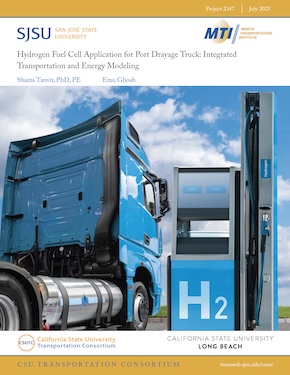- 408-924-7560
- mineta-institute@sjsu.edu
- Donate
Hydrogen Fuel Cell Application for Port Drayage Truck: Integrated Transportation and Energy Modeling
This report investigates the viability of hydrogen Fuel Cell Electric Vehicles (FCEVs) for port drayage applications, focusing on both energy modeling and economic feasibility. Port drayage—trucking operations that move goods a short distance to and from ports—is a key part of freight logistics and the critical movement of goods in American communities. This project developed a microscopic energy consumption model using second-by-second activity data from 38 Class 8 diesel drayage trucks operating in Southern California. The model emulated FCEV operations and determined an average hydrogen fuel consumption of 0.15 kg/mile across 749 trips. This data informed a levelized cost of hydrogen (LCOH) analysis under various production methods, station capacities, and fleet adoption rates. In other words, the analysis helps show conditions under which hydrogen FCEVs could become a cost-competitive and sustainable option for port drayage fleets. The project used two economic modeling approaches: a general parametric study and a comprehensive analysis using established spreadsheet tools (H2A-Lite and HDSAM-4.5). Results from the parametric study showed a concave relationship between hydrogen station capacity utilization and LCOH. Higher fleet conversion rates (e.g., 25%) significantly reduced LCOH (as low as $1.4/kg for blue hydrogen) but strained infrastructure, highlighting the need for strategic station deployment. Conversely, underutilized stations led to elevated hydrogen costs, especially with green hydrogen. This means that as station utilization increases, LCOH initially drops quickly—because more trucks using the station spreads out fixed costs, making each kilogram of hydrogen cheaper, but after a certain point, the rate of cost savings slows down—and, eventually, adding more demand may even introduce new costs (such as the need for upgrades). The comprehensive analysis reinforced these findings and showed that while grey hydrogen remains the cheapest to produce, green hydrogen—particularly from hybrid solar-wind PEM electrolysis—becomes competitive at scale. Delivery methods also impacted cost: liquid hydrogen delivery proved more cost-efficient at low utilization, while gaseous delivery was better suited for high-demand scenarios. The study concludes that achieving cost-effective hydrogen adoption for port drayage trucks hinges on optimizing station utilization, scaling infrastructure, and supporting green hydrogen technologies through policy and investment. Given the critical role of port drayage in transportation networks, this study helps lay the path forward toward decarbonizing a high-impact sector through hydrogen technology.
Shams Tanvir, PhD, PE
Dr. Shams Tanvir is an Assistant Professor in the Department of Civil Engineering and Construction Engineering Management (CECEM) at California State University, Long Beach (CSULB). His research aims to develop and characterize transportation technologies that minimize energy consumption and emissions while enhancing mobility efficiency and equity. Dr. Tanvir has published extensively on energy and emissions modeling of transportation systems, including zero and near-zero emissions transportation, as well as the unintended consequences of transportation technologies. He is a member of the Transportation Research Board committee on Highway Capacity and Quality of Service, and Transportation Air Quality and Greenhouse Gas Mitigation. He chairs the Sustainable Transportation committee at the American Society of Civil Engineers (ASCE). Dr. Tanvir received his PhD in Transportation Systems Engineering from North Carolina State University. He received B.S. and M.S. in Civil Engineering from BUET.
Emu Ghosh
Emu Ghosh is a graduate student in Civil Engineering at CSULB. She earned her Bachelor of Science degree in civil engineering from Bangladesh University of Engineering and Technology in 2023. With a passion for research, Emu has always aspired to contribute to ensuringsustainability and mobility in the transportation sector. Currently, Emu serves as a Research Assistant at the Sustainable Mobility Laboratory under Dr. Shams Tanvir. The laboratory'sprimary focus is to reduce energy consumption and emissions, thereby enhancing mobility and achieving sustainability in the transportation sector.
-
Contact Us
San José State University One Washington Square, San Jose, CA 95192 Phone: 408-924-7560 Email: mineta-institute@sjsu.edu






